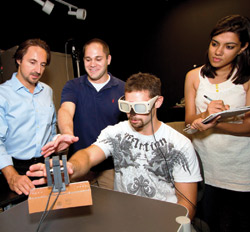The National Science Foundation (NSF) has awarded a $640,000 grant to fund research at Arizona State University (ASU), Tempe, that aims to better understand the sensory and cognitive connections between the brain and the hands. The research collaboration between Marco Santello, PhD, an ASU professor of biomedical engineering, and Columbia University, New York, New York, scientist Andrew Gordon, PhD, could benefit people with neurological disorders such as Parkinson’s disease and cerebral palsy and those who need prosthetic hands.
Santello and Gordon, who is a professor of movement sciences and the movement science program coordinator at Columbia, are seeking to determine the neural mechanisms that control learning and planning of the grasping and manipulation of objects. They’re examining the visual cues people use to assess object properties before they grasp or otherwise manipulate objects. In addition to using cues such as object shape or density, people often use memory of similar past actions.

Marco Santello and students in his lab conduct experiments in sensory and cognitive abilities. Photograph courtesy of Jessica Slater.
Santello’s focus is on neural control of the hand and the workings of senses such as vision and touch. By manipulating these senses in people with normal brain, hand, and muscle functions, Santello studies what causes the performance of an action that is easy under normal conditions to become difficult. This allows him to identify what impact a specific sense has on how the brain controls the hands.
In his experiments, he imposes sensory deficits on test subjects, using goggles to block vision at selected times during the object manipulation to interfere with the subjects’ abilities to learn and execute grasping tasks. “We want to understand what aspects of visual feedback help the brain to successfully control grasping of an object and store a memory representation of that action,” he explained.
Gordon’s research centers on cerebral palsy. His related collaborative work with Santello focuses on cognitive aspects of the interaction between the brain and the hands, assessing the information the brain gains and processes from sensing the shapes of objects and exploring the role of memory of past actions.
Knowledge gained by such research can also be applied to improving neuroprostheses. Current technology is able to provide sophisticated artificial hands, but controlling the hands remains a challenge.
“The more we understand about the high-level processing that the brain has to go through to plan an action, the closer we will be to building more intelligent prosthetic systems that are capable of more human-like performance,” Santello said.




